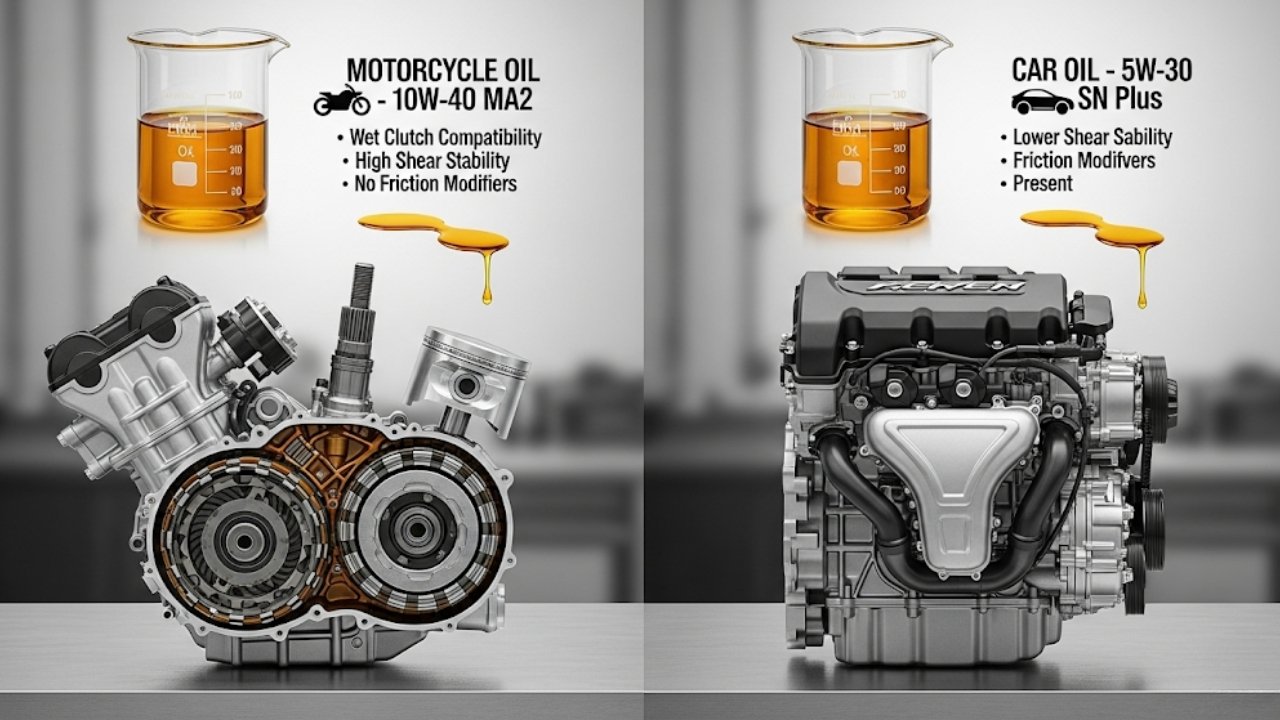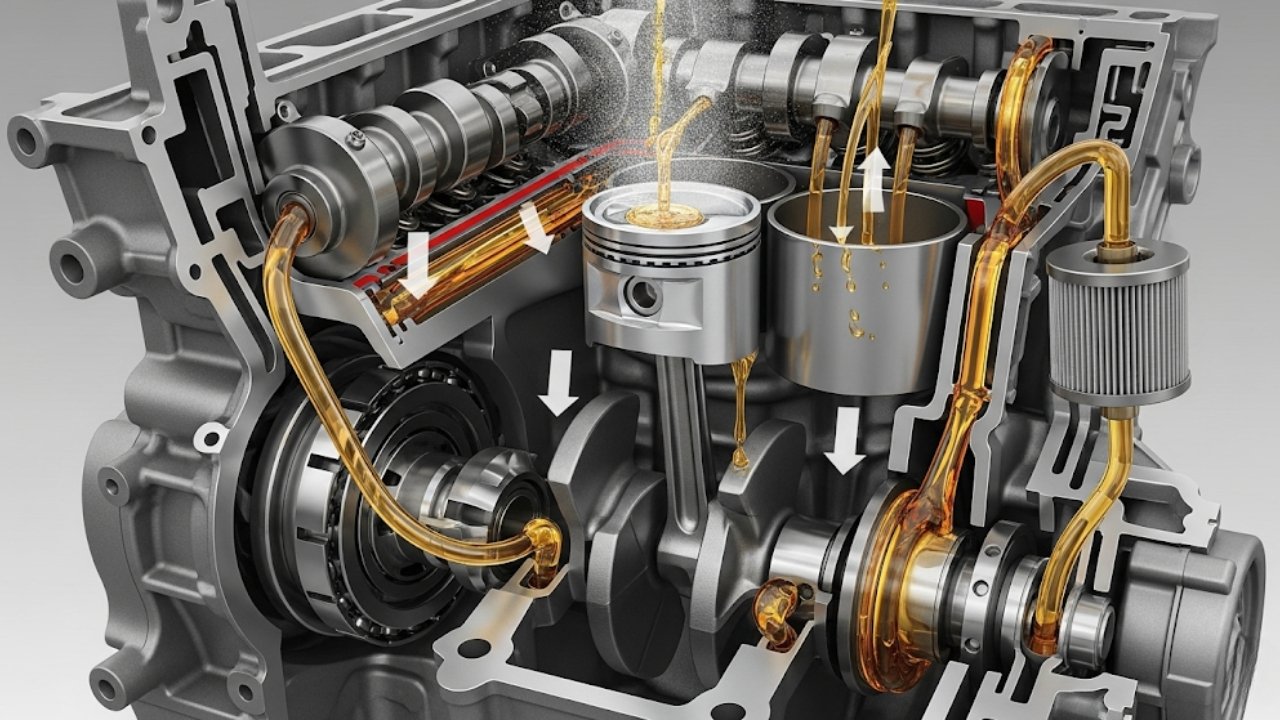Motorcycle Oil vs Car Oil: What’s the Real Difference?

If you’ve ever tried pouring car oil into a motorcycle, you’re not alone. I once did it out of desperation on a long road trip through the hills of Sylhet, Bangladesh. My little bike had run low on oil, and the nearest mechanic only had car engine oil. I took the risk—and regretted it soon after.
That moment taught me something important: motorcycle oil vs car oil isn’t just a branding gimmick. There’s real science, engineering, and nuance behind those labels. In this guide, we’ll unpack the exact differences between them, explore why they matter, and help you avoid making the mistake I did.
So, whether you’re a curious rider, a new car owner, or someone who loves the smell of motor oil on a Sunday morning, this article’s for you.
In This Article
- 1 Understanding the Basics: How Engine Oils Work
- 2 Internal Heat and Pressure: Two Different Worlds
- 3 The Clutch Conundrum: Wet vs Dry Systems
- 4 Additives and Formulation: The Secret Sauce
- 5 Viscosity Differences: More Than Just Numbers
- 6 Real-World Effects: What Happens If You Mix Them Up?
- 7 Choosing the Right Oil: It’s Not Just About the Brand
- 8 Synthetic vs Conventional: Does It Make a Big Difference?
- 9 Maintenance Matters: How Often Should You Change Oil?
- 10 Environmental Factors: Climate Can Influence Oil Choice
- 11 FAQs: Common Questions About Motorcycle Oil vs Car Oil
- 12 Final Verdict: Motorcycle Oil vs Car Oil—Which Should You Choose?
- 13 Personal Wrap-Up: Lessons from the Road
Understanding the Basics: How Engine Oils Work

Here’s what it does:
-
Lubricates moving parts
-
Reduces friction and wear
-
Cleans out sludge and debris
-
Maintains engine temperature
-
Protects against rust and corrosion
Both motorcycle oil and car oil serve these purposes. But the environments they work in are drastically different.
Motorcycle engines are smaller, rev higher, and often serve triple-duty—engine, transmission, and clutch—using the same oil. Car engines, on the other hand, are larger and separated from the transmission.
This key distinction creates the foundation for why the two oils are not interchangeable.
Internal Heat and Pressure: Two Different Worlds
If you’ve ever watched your bike’s tachometer during a highway sprint, you’ll notice it can go up to 10,000 rpm or more. Meanwhile, your car usually chills around 3,000 rpm.
That’s a big deal.
Motorcycle engines are more compact, generate higher heat, and operate under extreme stress. So, the oil inside needs to:
-
Handle high temperatures without breaking down
-
Offer superior shear stability (resistance to being torn apart at high speeds)
-
Work with a wet clutch system without slipping
On the flip side, car engines generally have:
-
Larger cooling systems
-
Separate oil for engine and transmission
-
Less pressure on the oil’s performance under high rpm
So while both oils aim to protect engines, their real-world tasks are drastically different.
The Clutch Conundrum: Wet vs Dry Systems
Here’s where the rubber really hits the road. Most motorcycles use a wet clutch system, meaning the clutch is bathed in the engine oil itself.
This is where motorcycle oil shows its true colors. It must:
-
Maintain friction levels for clutch grip
-
Prevent slippage under high torque
-
Avoid additives that make the clutch too smooth
Car oil often contains friction modifiers designed to enhance fuel economy and smooth out engine noise. These are great for cars but disastrous for bikes. If you use car oil in a motorcycle, it can cause:
-
Clutch slipping
-
Overheating
-
Rapid wear
I learned this the hard way when my bike’s clutch started slipping on uphill climbs. It felt like I was revving into the void—and that’s a scary feeling when a truck’s behind you.
Additives and Formulation: The Secret Sauce
Engine oils are not just crude lubricants—they’re carefully engineered formulas. Let’s look at how the additives differ between motorcycle oil vs car oil:
| Component | Motorcycle Oil | Car Oil |
|---|---|---|
| Friction Modifiers | Low (to prevent clutch slip) | High (to boost fuel economy) |
| Detergents | Moderate (controls sludge but not foamy) | High (keeps car engines extra clean) |
| Anti-wear Agents | High (handles extreme pressure) | Moderate |
| Shear Stability | Very High (withstands high RPM) | Standard |
As you can see, bike oil is like a multi-tasking superhero—balancing clutch, gearbox, and engine protection. Car oil, while still robust, is more of a one-job specialist.
Viscosity Differences: More Than Just Numbers
Ever noticed those numbers like 10W-40 or 5W-30 on your oil can?
They refer to oil viscosity—how thick it is at cold and hot temperatures. Both motorcycle oil and car oil use similar rating systems, but here’s the kicker:
Motorcycles usually need:
-
A wider viscosity range
-
High-temperature stability
-
Shear-resistant formulations
Cars are typically fine with oils that flow more freely under lower stress.
So even if the label says “10W-40,” car oil might behave very differently inside a bike. That’s why choosing oil by label alone can be misleading.
Real-World Effects: What Happens If You Mix Them Up?
Using car oil in a motorcycle can cause:
-
Clutch slippage (especially on high revs)
-
Gear shifting problems
-
Overheating
-
Shortened engine life
On the flip side, using motorcycle oil in a car isn’t exactly harmful, but it’s overkill. It might not hurt your engine, but you’ll be wasting money on extra additives your car doesn’t need.
Think of it like using a racing helmet for a bicycle ride—it works, but it’s not necessary.
Choosing the Right Oil: It’s Not Just About the Brand
So now you’re standing in the store, staring at shelves filled with oil bottles. Labels screaming 10W-40, synthetic blend, full synthetic, JASO MA2, API SN—and your brain feels like it’s about to explode.
Here’s what I’ve learned from years of working with bikes and cars:
When choosing motorcycle oil vs car oil, don’t just look at viscosity. Check for these specifics:
-
Motorcycle oil: Look for labels like JASO MA or MA2. These are certified safe for wet clutches and motorcycles in general.
-
Car oil: Usually rated by API SN, SP, etc., and may not include JASO certification.
You should never ignore the oil grade recommended in your owner’s manual. Yes, even if your friend swears by some fancy racing oil.
Pro Tip: Don’t buy based solely on price. Cheap oils often lack the protection your engine needs—and the damage shows over time.
Synthetic vs Conventional: Does It Make a Big Difference?
Yes, and no.
Both motorcycle and car oils are available in conventional (mineral), semi-synthetic, and full synthetic forms.
Synthetic oils:
-
Last longer
-
Resist breakdown at high temps
-
Offer better cold-start protection
Conventional oils:
-
Cost less
-
Need more frequent changes
-
Might be fine for older, low-performance engines
Most modern motorcycles and cars recommend synthetic or at least semi-synthetic oils. But here’s the twist—synthetic car oil still isn’t suitable for most bikes because of those friction modifiers.
I remember switching to a fancy car synthetic once for my 150cc bike—it ran smooth at first, but after 300 km, the gear shifts got crunchy and clutch response dulled. I switched back to bike oil, and it felt like my engine could breathe again.
Maintenance Matters: How Often Should You Change Oil?
One common mistake I see among new riders and drivers is pushing oil changes way beyond the recommended limit. That’s like not brushing your teeth for months!
Let’s break it down simply:
| Vehicle Type | Oil Type | Change Interval |
|---|---|---|
| Motorcycle | Mineral | Every 2,000-3,000 km |
| Motorcycle | Synthetic | Every 5,000-7,000 km |
| Car | Conventional | Every 4,000-5,000 km |
| Car | Synthetic | Every 8,000-10,000 km |
Keep in mind—riding in dusty areas, frequent traffic stops, or aggressive driving shortens oil life significantly.
Helpful Tip: Always change your oil filter when you change your oil. Otherwise, you’re leaving dirty oil circulating inside.
Environmental Factors: Climate Can Influence Oil Choice
Whether you’re riding through the humid monsoon roads of Dhaka or cruising the cool mountain roads of Nepal, temperature plays a role.
-
Hot climates demand oils with higher thermal stability.
-
Cold areas require oils with better flow at low temperatures (like 5W-30 or 0W-40).
Motorcycle oils tend to be more versatile due to the high-rpm nature of engines, while car oils are tuned more for stable driving conditions.
️ My advice: Stick to the oil grade your manufacturer recommends, but opt for synthetic if your local climate is extreme—either hot or cold.
FAQs: Common Questions About Motorcycle Oil vs Car Oil
1. Can I use car oil in my motorcycle just once?
Technically, yes—but it’s risky. Car oils often cause clutch slipping and wear in motorcycles. Avoid it unless it’s a true emergency.
2. What happens if I use motorcycle oil in my car?
Nothing catastrophic, but it’s not cost-effective. Motorcycle oil is formulated for higher stress and may be overkill for car engines.
3. Is synthetic oil better for motorcycles?
Generally, yes. It offers better protection, longer intervals, and smoother performance—especially in hot weather or long-distance riding.
4. How do I know if oil is motorcycle-safe?
Look for JASO MA or MA2 certification on the bottle. That confirms it’s safe for your bike’s wet clutch system.
5. Does motorcycle oil expire?
Yes, both in the bottle and inside your engine. Opened bottles should be used within a year, and oil inside your bike should be changed as per schedule—even if you don’t ride often.
Final Verdict: Motorcycle Oil vs Car Oil—Which Should You Choose?
Choosing between motorcycle oil vs car oil isn’t just a brand decision—it’s a mechanical necessity. Each is built for a purpose:
-
Motorcycle oil is tailored to high-rpm, wet clutch, and compact engine demands.
-
Car oil is made for smooth, stable, and low-rpm performance with cleaner burn and fuel efficiency.
In short—don’t mix them up.
Even if the viscosity rating looks the same, the internal chemistry is not. Using the wrong oil can lead to expensive repairs and frustrating rides.
Personal Wrap-Up: Lessons from the Road
I’ve ridden everything from a 100cc commuter to a 650cc twin-cylinder beast. One thing I’ve learned is this—respect your engine and it will respect you back.
The oil you pour in is like the fuel for your bike’s soul. When you choose right, the throttle feels crisp, the gear shifts click, and the ride becomes poetry.
So next time you’re about to top off your engine, pause for a second. Ask yourself: “Is this oil made for my machine?”
If it’s not motorcycle oil, don’t do it. Your bike—and your future self—will thank you.






